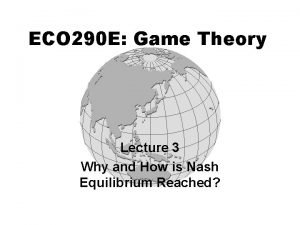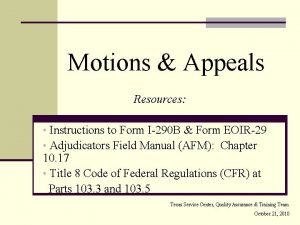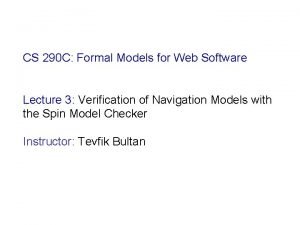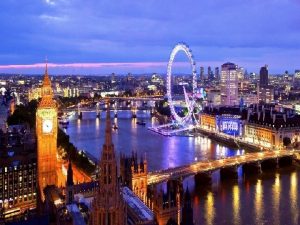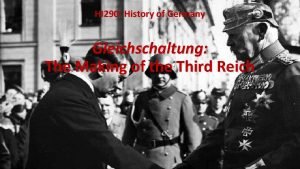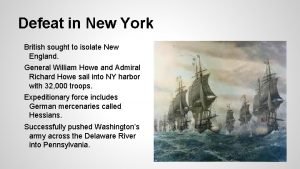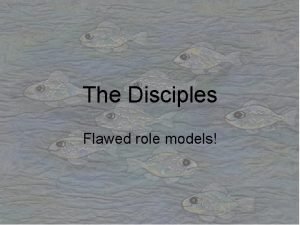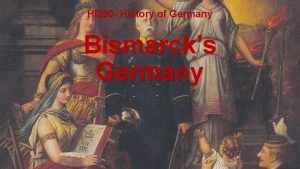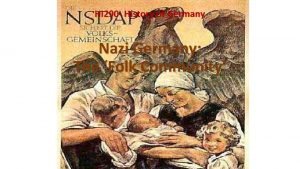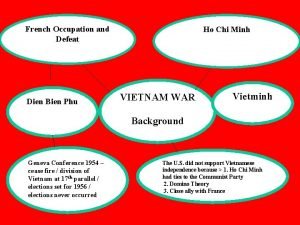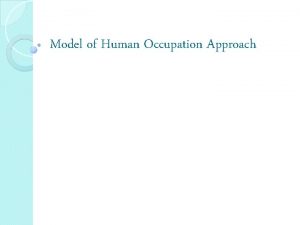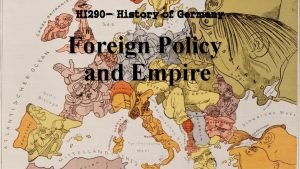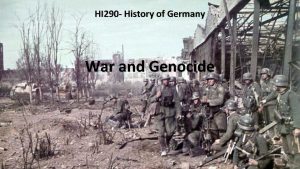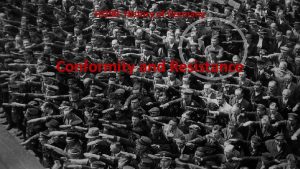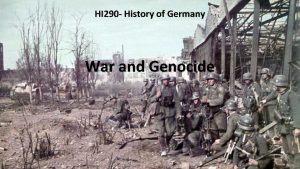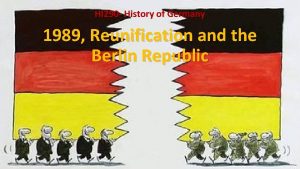HI 290 History of Germany Defeat Occupation and
















- Slides: 16

HI 290 - History of Germany Defeat, Occupation and Division

The Allies and the Future of Germany Churchill, Roosevelt and Stalin at the Yalta Conference, February 1945 US Secretary of the Treasury, Henry Morenthau Jr. (1891 -1967), whose name was given to the plan to reduce Germany to a deindustrialised and divided nation.

Aerial view of Dresden after allied bombing Allied troops enter Berlin, 1945

Source: R. Overy, The Penguin Historical Atlas of the Third Reich Child refugees deported from Poland to West Germany, 1948.

Occupied Berlin

The Nuremberg trials

Denazification • Four-power agreement on the need to remove Nazis from the civil service, judiciary, education etc. • Differences in approach: • Russians saw Nazism as an outgrowth of German capitalism – radical structural reforms. • Americans wanted to remove Nazism but maintain the existing social & economic structure – a more bureaucratic approach. • British & French saw Nazism as inherent in the German national character – an emphasis on reeducation. • Denazification ultimately devolved to German tribunals.

Democratization and Decentralisation • 1947: Break up of the old state of Prussia. • Creation of new administrative areas (Länder) within the zones of occupation. • Differences in approach: • A more centralized approach in the British zone – unelected German officials made up Central Economic Office & Zonal Advisory Council. Municipal elections in autumn 1946, elections to state assemblies in May 1947. • The Americans keen to introduce democracy as soon as possible: elections held in Jan. 1946. By the beginning of 1947 power had been devolved to the Länder in the US zone. • The Russians established a central authority, the Soviet Military Administration of Germany (SMAD), in July 1945 at the same time as governments in the Länder in their zone.

The Economy Dismantling the Krupps armaments factory at Essen "An Open Road for the Marshall Plan" (c. 1948), poster advertising the advantages of US economic aid.

Trümmerfrauen (rubble women)

New Political Parties and Deepening Divisions • CDU/CSU – social conservative Christian party • FDP – liberals • SPD in West Germany • 21 April 1946: Merger of the SPD and KPD in the Soviet Zone to form the Sozialistische Einheitspartei Deutschlands (Socialist Unity Party, SED) • 1947: British and American Zones merged. • 1947: ‘Marshall Plan’ = $13 billion aid to help rebuild European economies. “Unity” (1946): poster commemorating the merger of the SPD and KPD.

The Berlin Blockade • 20 June 1948: A new currency, the Deutschmark, introduced in Bizonia, the French Zone and West Berlin. • The Russians fear that this will destabilize the economy in their zone & move to cut off road & rail access to West Berlin in the hope of pressuring the west to abandon their plans for a separate state. • June 1948 -May 1949: The allies airlift fuel & food into West Berlin. • A symbolic struggle that back-fired on the Russians & only accelerated the integration of West Germany into the Western European system.

The Formation of the FRG • July 1948: 65 member Parliamentary Council established to draw up a constitution for the Western zones. • 10 Feb. 1949: The proposed constitution presented to the Military Governors for their approval. • 8 May 1949: The Parliamentary Council adopts the ‘Basic Law’ by a vote of 53 to 12. • Elections in August return a majority for a centre-right coalition of the Christian Democrats (CDU) and the Free Democrats (FDP). • Konrad Adenauer elected first Chancellor of the Federal Republic of Germany on 15 September 1949.

The Formation of the GDR • Despite the long build up, the establishment of the FRG took both the Russians and the East Germans by surprise. • Stalin still hoped that a single neutral German state could be formed and was reluctant to agree to proposals from the SED leadership for a separate state in the East. • But establishment of the Federal Republic ended such hopes and on 7 October 1949 the establishment of the German Democratic Republic was announced. • A draft constitution had already been drawn up in the spring – on paper this was very similar to that of FRG. In practice the GDR was a single-party state dominated by the SED backed up with Russian tanks. • 12 October: A new government led by Otto Grotewohl formed.

The Berlin Wall The wall the symbolised the division of Germany (and Europe) under construction, 1961 Conrad Schumann jumping over the barbed wire to defect to the West during the construction of the Berlin Wall, 15 August 1961

Conclusion • Germany’s total defeat in WW 2 placed her in the hands of the Allies. • Most Germans were more interested in the day-to-day struggle to survive than politics. • The division of Germany therefore has to be seen in the context of emerging Cold War tensions between the Superpowers. • Historiography: • Orthodox school = the Soviet Union primarily to blame for the Cold War & division of Germany. • Revisionist school = the Western powers (and the USA in particular) primarily to blame for the Cold War & division of Germany. • Post-revisionist school = both sides share equal blame – the division of Germany a consequence of mutual suspicion and irreconcilable ideological differences.
 Specs 290 and jones
Specs 290 and jones 30 tac 290
30 tac 290 A 290. számú auschwitzi fogoly
A 290. számú auschwitzi fogoly Eco 290
Eco 290 I 290 b
I 290 b Cs 290
Cs 290 Www.coloradoui.gov.myuiemployer
Www.coloradoui.gov.myuiemployer History of physical education in sweden
History of physical education in sweden Germany history
Germany history Defeat by kahlil gibran
Defeat by kahlil gibran 12 ways to defeat multi-factor authentication
12 ways to defeat multi-factor authentication Kneeling in defeat
Kneeling in defeat Defeat at ai
Defeat at ai So gold can easily triumph defeat strongest man
So gold can easily triumph defeat strongest man By your spirit i'm alive from the ashes of defeat
By your spirit i'm alive from the ashes of defeat 32 000 troops in new york harbor
32 000 troops in new york harbor Characteristics of simon peter
Characteristics of simon peter



